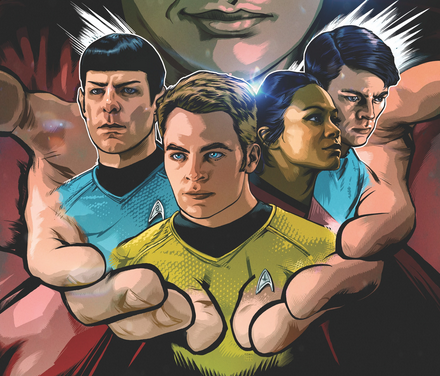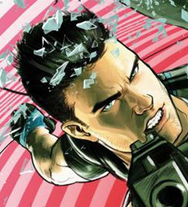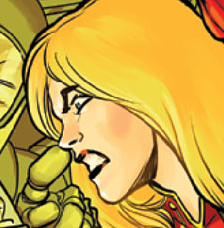Deadshirt Is Reading… is a weekly feature in which Deadshirt’s staff, contributing writers and friends-of-the-site offer their thoughts on a diverse array of comics, from name-brand cape titles to creator-owned books to webcomics.
Dylan Roth is reading…
Star Trek #35
Written by Mike Johnson
Art by Tony Shasteen
Lettered by Neil Utetake
IDW
“I belong to an immortal race of extra-dimensional beings who can manipulate the time and space of your reality the way that you would change the water in a fishbowl. You’re the fish, if my analogy isn’t clear enough.”
Like any comics series based on an ongoing non-comics property, current Star Trek comics suffer from a significant handicap in that their stories are basically just treading water between the events of the feature films. While each summer blockbuster release has been bookended by a pair of companion comics miniseries that expand and greatly enhance the film, the ongoing Star Trek series is dedicated to telling small, short stories with very little continuity between them. To a degree, this is an admirable tribute to the structure of the classic Star Trek television series that spawned the new movie franchise, but it comes at the cost of character development and legitimate stakes.
This month sees the beginning of a six-issue storyline, “The Q Gambit,” a real turning point for IDW’s ongoing Star Trek series. First, the obvious: while the series has included a number of stories directly based on classic Trek episodes, and made multiple allusions to the decades of existing source material, “The Q Gambit” features the new movie crew’s first real crossover with the Prime Universe from which it was born. Second, this will be the series’ first six-issue story, meaning it aims for a larger scale than the shorter, more episodic stories readers are used to. This is Star Trek: Ongoing‘s first real “event.”
In “The Q Gambit,” the omnipotent cosmic trickster Q (a fan-favorite antagonist who appeared in twelve Trek episodes across three different series) visits the Prime Universe’s Jean-Luc Picard to warn him that his friend Spock is not only alive and well but in an alternate reality of his own making, and that his presence there puts the new universe in jeopardy. From there, Q ports over to the new Enterprise of the JJ-verse to torment Kirk and his crew, leading up to an unprecedented twist ending that’s sure to make die-hard fans mouths’ water.
Writer Mike Johnson is clearly looking to have some fun with this story. There’s never been a (canonical) story of Q interacting with any universe’s Kirk and company, let alone the young emotional crew of the new films. Q is a wiseass with in-depth knowledge of the classic continuity, and has already begun to comment on the new one much in the way that old fans like to do, which could be fun to read if it’s not taken to annoying extremes. The ending promises big, big, time-and-space-hopping adventure, and maybe even some repercussions on the film universe.
As with most Trek comics, the art suffers from too much focus on strong likenesses of the film and TV actors. A keen (read: obsessive) eye can recall the specific frames of the films from which the characters are drawn, which can really interfere with the immersion process while reading. The likenesses are mostly excellent, but the expressions are muted and it doesn’t make for great comics. (The starships, on the other hand, look gorgeous.) On the whole, this is an exciting beginning to what could be the series’ first truly memorable story.
Jason Urbanciz is reading…
Written by Tim Seeley and Tom King (story co-writer)
Art by Mikel Janin (pencils and inks) and Jeromy Cox (colors)
Lettered by Carlos S. Mangual
DC Comics
“The downside of a solo act. No one around to see you do the cool stuff.”
With Dick Grayson unmasked as Nightwing and assumed dead in the aftermath of Forever Evil, DC has put him on a new career track as a super-spy in his new series, Grayson. It’s easy to try and compare it to Marvel’s Winter Soldier series, old sidekick + fake death + espionage, but thankfully the equation has a different result this time around. Where Bucky was and is a stone killer, Dick’s only use of a gun in this issue is as a makeshift Batarang. With Dick now working for Spyral (a leftover spy agency concept from Grant Morrison’s Batman Incorporated run), he’s helping them to do their dirty work to secretly control the DC Universe while also spying on them for (presumably) Batman. This comic seems to be picking up on some of the dangling concepts from Batman, Inc. which is pretty great since Morrison’s work was a favorite of mine.
The art by Mikel Janin also seems to play with a lot of the visual cues from Morrison’s run, using deep patterned backgrounds and varying page layouts help make the book look different from most of what DC is putting out right now. Janin’s art is very clean and fluid, like a combination of Jamie McKelvie and Cameron Stewart. His work is greatly helped by Jeromy Cox’s bright colors, especially during action scenes, where he uses bright secondary colors for the backgrounds which help show the speed of the action.
This is a really great start to the series. This first issue moves swiftly but packs a lot in. While there is a lot of unpack in there from Morrison’s run, it’s still totally new-reader friendly to anyone who hasn’t picked up his run or any other DC comics in a while.
Christina Harrington is reading…
Written by Kelly Sue Deconnick
Art by David Lopez (pencils and inks) and Lee Loughridge (colors)
Lettered by VC’s Joe Caramagna
Marvel
“Tend to the business of the Avengers and leave us to the future we have made.”
“Higher, Further, Faster, More: Part Five” finds the narrative all caught up to the time jump that introduced this arc, meaning that Captain Marvel has successfully found herself on an alien planet, though not before losing her young alien friend, named Tic. Tic’s race was one of the many who lost their home planet during the war with the Builders, and their new planet, generously gifted to them by Spartax Emperor J’son (father of Guardians of the Galaxy member Peter Quill) hasn’t been working out too well either. In fact, it’s been poisoning them, leading to the impossible choice of leaving the planet (and the ill to die) for an existence of wandering the galaxy in a migrant fleet or staying on their new home only for the whole race to die out. This issue solves the mystery of the poisonous planet, and further villainizes the already shifty Spartax Emperor.
“Higher, Further, Faster, More” has been an enjoyable space caper, and at its best when the good Captain is surrounded by her new alien friends, allies, and enemies. Using the Guardians of the Galaxy to acclimate readers to the new setting was a smart idea, but if there’s one thing this arc has done better than anything else, it’s creating a bountiful and complicated new cast of characters. These original characters are refreshing in their originality, not only in their design (and refreshing is definitely the word I’d use to describe Lopez’s alien designs, aided here by Loughridge’s vibrant coloring), but in their behavior in the small amount of characterization we’ve seen. Eleanides, the elderly, lizard-like leader of Tic’s people, is especially compelling. Though cold at times, Eleanides is a calculating matriarch, wholly devoted to the cause of her people, even if that means striking backroom deals with the (at best) morally gray J’son. These new characters have elevated a storyline that could have otherwise just been “Captain Marvel, but in space” into a storyline that has real weight and lasting stakes.
Patrick Stinson is reading…
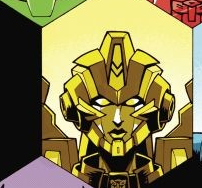 The Transformers: More than Meets the Eye #31
The Transformers: More than Meets the Eye #31
Written by James Roberts
Art by Attilio Rojo (pencils and inks) and Joana Lafuente (colors)
Lettered by Tom B. Long
IDW
“It’s strange, isn’t it? So many Autobots owe their lives to you. Without your war, they wouldn’t be here.”
Now that the three-part story that sort-of explains how Megatron got to be captain has concluded with the mysterious disappearance of the Lost Light, I was hoping that we’d get back to the patented MtMtE formula of compelling one- and two-part stories nestled in a crunchy megaplot. Instead, the serialization is continuing. This issue is structured like a one-off, a classic locked-room murder mystery with a sci-fi twist. However, it doesn’t answer any of the questions it raises, nor conclude any of the plots it advances.
This isn’t necessarily a bad thing, as The Transformers has always presented compelling characters in merely serviceable plots. And this issue is even more packed with character development, world-building, and fourth-wall-bending cleverness than most MtMtE stories. But despite their best efforts, Roberts and Rojo don’t really provide much for new readers to grab onto here. The quiet, ratcheting tension of the situation is well-emphasized by Rojo’s layouts, but is somewhat belied by the overly casual dialogue. Admittedly, it’s always a shame when Alex Milne skips an issue, because even the most serviceable replacement leaves you wondering what mad wonders from his pencil that you missed out on.
The conclusion of the mystery is clever on two fronts. First, Nightbeat gets chewed out by Megatron (of all people) for solving it too late to actually help anybody. Second, the element that unites all the lost characters will make you feel surprised and even a little guilty if you don’t solve it before Nightbeat does…and I certainly didn’t. For longtime readers, it’s a bit of a gauntlet thrown down: Roberts is challenging himself to write these characters over here just as well than he previously wrote those characters over there, and challenging you to give him a chance and love them just as much. But much like the latest cinematic installment of Transformers, not to mention Windblade #3, the ending cliffhanger is so devoid of context that it doesn’t land with the force that it ought to.
In an extra bit of class from IDW, this issue foregoes ads in order to create a cool effect with full-page crew manifests that update as disappearances occur and new information is learned. However, this is a wash due to uniquely atrocious copy-editing, with distracting typos in key scenes. Bottom line: recommended if you like Transformers and Doctor Who, particularly the “Midnight” episode of the latter.
Kayleigh Hearn is Reading…
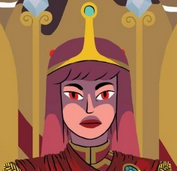 Adventure Time: Banana Guard Academy #1
Adventure Time: Banana Guard Academy #1
Written by Kent Osborne and Dylan Haggerty
Art by Mad Rupert
BOOM! Studios
“Why is Root Beer Guy looking in our window?!”
Banana Guard Academy is the latest spin-off of BOOM! Studios’ Adventure Time comic, a six-issue mini-series spotlighting Princess Bubblegum’s elite Banana Guards and their captain, the very literally-named Root Beer Guy. One of the great things about Adventure Time is that it’s unafraid to expand the show’s universe beyond heroes Finn and Jake, and BOOM! has previously released a myriad of books about supporting characters like Flame Princess, Peppermint Butler and Cinnamon Bun, and Lumpy Space Princess. Yet Banana Guard Academy feels like a bit of a risk—Root Beer Guy starred in only one self-titled episode of the animated series, before (bow your heads) being killed in the Season 6 episode “Something Big.” I was unsure if the premise was strong enough for six issues, but it’s a fun beginning.
What gives Banana Guard Academy extra weight is that’s it’s co-written by Kent Osborne, a writer and storyboard artist on Adventure Time (he also voices Finn and Jake’s dad, Joshua the dog). Osborne obviously knows the characters and their world, and he and Dylan Haggerty punch up the story with great comedic timing. Mad Rupert’s art is lively and cute (has an Adventure Time comic ever had bad art?) and full of great character moments, like Bubblegum descending a staircase of enormous books, or Mr. Cupcake’s face illuminated by dramatic sparkles when he talks about love. And it’s rare to talk about lettering in a comic book, but Leigh Luna’s work is great—during a scene in which Princess Bubblegum and Root Beer Guy are in a kitchen, rattling off the names of food, the letters and each individual word bubble take the shape of the food they’re describing, giving the artwork a whimsical, storybook quality.
BOOM! Studios’ Adventure Time comics have proven themselves to be some of the strongest all-ages comics on the market, and it looks like Banana Guard Academy is a fun new addition to the line. So pour one out for Root Beer Guy (RIP).
Thanks for reading about what we’re reading! We’ll be back next week with a slew of suggestions from across the comics spectrum. In the meantime, what are you reading? Tell us in the comments section, on Twitter or on our Facebook Page!

